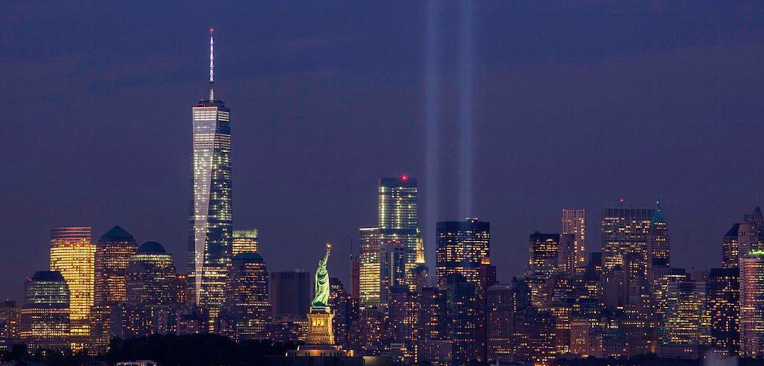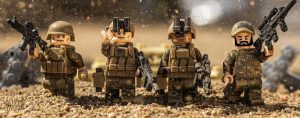As the towers fell and the nation reeled on Sept. 11, 2001, a team of New York Air National Guardsmenat the Northeast Air Defense Sector (NADS) in rural Rome, New York were tasked with searching for missing plans and scrambling fighters in response to the attacks.
Since renamed the Eastern Air Defense Sector, Air Guardsmen there were at the center of the military’s air response on that day. On duty for a NORAD training exercise, Vigilant Guardian, they now have a unique view on the events of Sept. 11, 2001, thanks to their roles in the response.
New York Air National Guard Maj. Jeremy Powell was a 31-year-old tech sergeant taking part in Exercise Vigilant Guardian when 9/11 occurred. He was the first military person to learn about the hijackings after taking the initial call from the Federal Aviation Administration’s Boston center. Master Sgt. Stacia Rountree was a 23-year-old senior airman working as an identification technician. Vigilant Guardian was her first major NORAD exercise.
Like every other American, Powell and Rountree remember that day vividly. Here are eight things they recall about the day that you might not know.

After Sept. 11, 2001, this is what the NEADS operation floor looked like. Above the Q-93 (the large green radar scope) is the NORAD contingency suite that was installed immediately after 9/11 to provide radar data of the entire country.
(Master Sgt. Stacia Rountree, Eastern Air Defense Sector)
It was not a drill
It took some time for NEADS to realize 9/11 was a real-world scenario and not part of the exercise. Once they did, there was even more confusion trying to find the missing planes, which always seemed to be a step ahead of them.
“We were treating all the information we got as real-time, not understanding that it was coming to us late,” said Rountree, who basically became a liaison between the FAA and the military for the rest of that day.
“We were trying to figure out departure destination, how many people were on board, how big the aircraft actually was, and factoring all of that stuff in. That way the [F-15 and F-16] fighters, when they got airborne, would know that they had the right plane in sight,” she said.
“I stayed on the phone for 12-14 hours, just calling all the bases and asking how quick the fighters could get armed, get airborne, and if they could go to a certain location,” Powell said.
There was little time between FAA call and the first crash
Just 10 minutes elapsed between the time Powell took the first call to NEADS about the hijackings to when the first plane, American Airlines Flight 11, hit the North Tower — not enough time to get fighters into the air.
According to the 9/11 Commission’s report, the call from the FAA’s Boston center came into NEADS at 8:37 a.m.
“8:46 is when I scrambled the first fighters [from Otis Air National Guard Base, Massachusetts], and then 8:53 they were airborne,” Powell said.
But it was too late to help American 11, which hit the World Trade Center’s North Tower at 8:47 a.m.
There were several more reports of hijackings over the day
By the time the day was over, Rountree said there were probably 19 or 20 planes that she and the other ID techs had investigating as possible hijackings. Only the initial four — American 11, United Airlines Flight 175, American Airlines Flight 77 and United Airlines Flight 93 — were the real deal.
At one point, there were reports that American 11 was still airborne. Air traffic controllers likely confused it with American 77, which was somewhere over Washington, D.C. air-space.
Rountree said she tried to contact the FAA’s Washington Center to get a position on it, while Langley Air Force Base fighters were trying to get to the capital.

New York Air National Guard Maj. Jeremy Powell, a tech sergeant on 9/11, was asked to play himself in the Paul Greengrass film “United 93” about the passengers who kept the fourth hijacked plane from reaching its destination in Washington, D.C. Powell, pictured here in a screen grab from the film, said he believed the movie was as spot-on as you could get, as far as what happened at NEADS was concerned.
“It was probably only a couple of minutes, but to me, it seemed like a lifetime. Then we got the reports that the plane hit the Pentagon,” Rountree remembered. “I was actively trying to find that plane, and I felt that we may have had some time. We didn’t.”
Fighter pilots were ready to make the ultimate sacrifice
The fighters were meant only to shadow potentially hijacked planes, but Rountree said there was discussion of those pilots making the ultimate sacrifice.
“In case their weapons were out, and if we would have had to use force, they were discussing whether or not those guys would have to go kamikaze,” she said, meaning some pilots were considering risking their own lives by using their planes to stop hijacked jetliners. “It was scary, when you thought about the possibility of them having to do that.”
There was a moment of hope for Flight 93
While all of the crashes were shocking, Rountree said that, for her, United 93 was the saddest. They had been trying to find the plane on radar and had called the FAA to get an updated position.
“They said, ‘It’s down,’ and we were thinking it landed,” Rountree remembered. But when they asked for landing confirmation, the info was clarified — it crashed. “For us, you had that glimmer of hope, and then… .”
NEADS was evacuated September 12
The day after 9/11, NEADS was evacuated because there was an unknown plane up at the time, and no one was supposed to be airborne.
“There were fighters coming back from air patrol over NYC … so our commander had them go supersonic over to where we were so they could figure out what it was. They thought it was heading toward us,” Rountree said.
It turned out to be a harmless floatplane, and it was forced to land.
9/11 changed the role of the air defense sectors
“Back then, the primary focus was that we were looking out at people coming to attack us from the outside,” Powell said. “We weren’t really focused on the inside.”
“Nobody thought that somebody would go ahead and utilize planes that were in the U.S. to do something, so our radar coverage was indicative of that,” Rountree explained. “Now, our coverage has definitely increased. It’s night and day versus then.”
The sector now has new and evolving technology.
“Our computer systems are bigger and better. … You should see all of the radars that are now hooked up. Everything the FAA sees, we see. We are much more actively involved in the identification of all aircraft in the United States,” Powell said.
Before 9/11, Rountree said they couldn’t always get in touch with critical personnel at the FAA centers. Now they can.
“We really didn’t have to talk to the various Air Traffic Control Center supervisors. Now, we have instant lines with everybody,” she said.
The military has been monitoring the skies over the U.S. ever since.
“A lot of people didn’t even realize that we were probably there, or what we even do, which could be a good thing,” Powell said. “It reinforces the idea that somebody’s always watching you, especially in the sky. The FAA’s there — that is their airspace — but the military is, too.”
Never Forget.
This article originally appeared on the United States Department of Defense. Follow @DeptofDefense on Twitter.
READ NEXT: 5 FACTS ABOUT THE MOST DECORATED SOLDIER IN HISTORY



